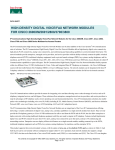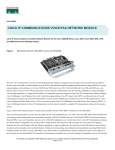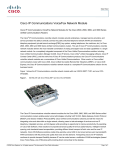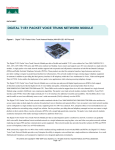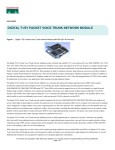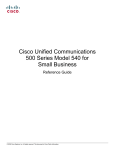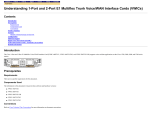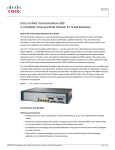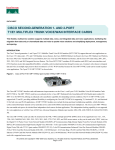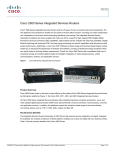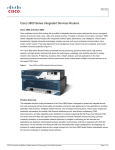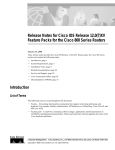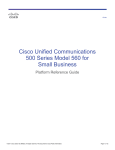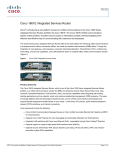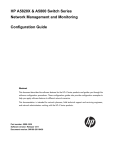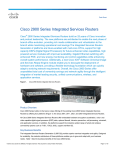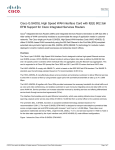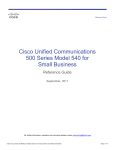Download Cisco 2-port E&M voice/fax
Transcript
Data Sheet High-Density Digital Voice/Fax Network Modules for Cisco 2800/2900/3800/3900 Series The IP Communications High-Density Digital Voice/Fax Network Modules are an addition to the Cisco ® Systems IP Communications suite of solutions. The IP Communications High-Density Digital Voice/Fax Network Modules deliver high-density digital voice connectivity, high-density WAN connectivity, analog voice connectivity, and conferencing and transcoding capability in a network module form factor. The network modules provide enterprises, managed service providers, and service providers with the ability to directly connect the public switched telephone network (PSTN), traditional telephony equipment (such as private branch exchange (PBX), key systems, analog telephones, and fax machines), and WAN ® to Cisco 2811, 2821, 2851, 2911, 2921, 2951, 3825, 3845 and 3925, 3945 Unified Communications Routers for either IP Communications capabilities or pure toll bypass. The IP Communications HighDensity Digital Voice/Fax Network Modules flexibly operates within two different Cisco Unified Communications (UC) environments—the Cisco Unified Communications Manager (UCM) system with Survivable Remote Site Telephony (SRST) or Cisco Unified Communications Manager Express (UCME). The network modules can be integrated with these IP Telephony solutions in a Unified Communications Router, to provide a complete IP Communications solution for full service branch customers. Figure 1. NM-HDV2-2T1/E1 with a 2-Port FXS VIC Cisco IP Communications solutions provide the means for integrating voice and data allowing users to take advantage of services such as IP telephony, integrated services, and toll-bypass. These solutions allow enterprises, managed network service providers, and service providers to reap the advantages of Unified Communications such as lower operating costs and increased productivity. Cisco Unified Communications solutions also enable packet voice technologies including voice over IP (VoIP) (including H.323, Media Gateway Control Protocol (MGCP), and Sessions Initiation Protocol (SIP), voice over Frame, voice over ATM (including AAL2 and AAL5 adaptation layers). The IP Communications High-Density Digital Voice/Fax Network Modules are an integral part of the Cisco Unified Communications offering, delivering a versatile combination of digital voice, analog voice, and data capabilities in a single network module form factor. They not only provide the IP telephony gateway to Cisco UC architectures for calls to and from the PSTN and the WAN, but also allow enterprises to deploy networks with existing traditional telephony equipment until they are ready to migrate to IP telephony. Features include high-density digital voice and WAN connectivity up to four T1/E1 ports, analog voice connectivity up to four ports, and up to 50 conferencing and transcoding sessions1. Enterprises can now deploy all these rich features on a single network module, enabling connectivity to the PSTN, traditional telephony equipment such as PBXs, key systems, analog telephones, fax machines, and the enterprise WAN. © 2009-2010 Cisco and/or its affiliates. All rights reserved. This document is Cisco Public Information. Page 1 of 12 Data Sheet This product supports three network module versions, with the option of zero, one, or two built-in T1/E1 ports, as shown in Table 2. Each built-in port can be conveniently software-configured to support either T1 or E1 operation. Each network module also supports a single VIC/VWIC slot that can be fitted with a Cisco voice/WAN interface card (VWIC) or voice interface card (VIC). The Cisco VICs are daughter cards that install into the network modules and provide the interface to the PSTN and to telephony equipment (PBXs, key systems, fax machines, phones). The Cisco VWICs are daughter cards that provide the interface to the PBX, PSTN, and/or WAN. Figure 1 shows a NM-HDV2-2T1/E1 with two built-in T1/E1 ports and a VIC3-2FXS/DID in the VIC/VWIC slot. Cisco VWICs supported include 1- and 2-port T1 and E1 interface cards with optional drop-and-insert capability along with a G.703 interface card option. These cards cover a full range of digital voice and WAN connectivity options. A variety of VIC options are supported including 2-port foreign exchange station (FXS), direct inward dial (DID), foreign exchange office (FXO), E&M (ear and mouth) analog interface cards, 4-port FXS and 4-port FXO cards and a 2-port ISDN Basic Rate Interface (BRI) digital interface card providing -40V phantom power. These cards cover the entire range of analog connectivity options along with user-side and network-side digital BRI connections. Please see Table 3 below for details on options supported. The IP Communications High-Density Digital Voice/Fax Network Modules are used with the PVDM2 Packet Fax/Voice DSP modules, providing scalability from 4 to 120 channels and featuring the latest digital signal processing technology. A maximum of four PVDM2s can be installed on each NM-HDV2 network module. The IP Communications High-Density Digital Voice/Fax Network Modules that are deployed on the Cisco 2811, 2821, 2851, 2911, 2921, 2951, 3825, 3845, 3925 and 3945 Unified Communications Routers can also be conveniently used with the onboard PVDM2 DSP modules (on the 2800 and 3800 Series only). The PVDM2s are not supported on the Cisco 2900 and 3900 Series motherboards. Enterprises can conveniently select the minimum number and densitytype PVDM2s depending on the voice channels they are deploying, and scale the number of PVDMs as they expand. These PVDM2 can be configured for high-, medium- or flex complexity via software. Flex complexity is the default configuration, and in this mode, the network module will dynamically negotiate the appropriate codec (medium or high) on a call-by-call basis depending on the PVDM2s available. Enhanced Cisco conferencing and transcoding features on the IP Communications High-Density Digital Voice/Fax Network Modules are available. The network modules provide a hardware-based conference resource at branch offices to facilitate multiparty conferences, thereby reducing the costs of delivering conferencing resources across the WAN. Transcoding resources within the same network module further reduces bandwidth consumption and costs by compressing traffic across the WAN, and enabling communications between devices that support different codecs. Up to 50 eight-party G.711 ad-hoc conferences, and up to 32 eight-party multicodec (G.711/G.729) ad-hoc conferences can be supported on a single IP Communications High-Density Digital Voice/Fax Network Module. © 2009-2010 Cisco and/or its affiliates. All rights reserved. This document is Cisco Public Information. Page 2 of 12 Data Sheet The IP Communications High-Density Digital Voice/Fax Network Modules are integrated in the Cisco 2811, 2821, 2851, 2911, 2931, 2951, 3825, 3845, 3925, and 3945 Unified Communications routers and are interoperable with the full range of Cisco IP Communications solutions—including Cisco IP phones, Cisco UCM, Cisco UCME, Cisco Unity software, Cisco Unity Express, Cisco IP Contact Center (IPCC), and Cisco IPCC Express. Up to four network modules can be configured in a Cisco 3845 and 3945 Unified Communications Router, supporting up to 480 and 720 voice channels in medium complexity codec on the Cisco 3845 and 3945, respectively. The IP Communications High-Density Digital Voice/Fax Network Module combined with Survivable Remote Site Telephony (operating with Cisco UCM) or Cisco UCME in a Unified Communications Router makes an ideal single-box communications solution for IP telephony in branch offices. Table 5 lists the maximum number of network modules that are supported on a Unified Communications Router. Important Features and Benefits Table 1. The IP Communications Digital Voice/Fax Network Modules Provide a Wide Range of Features and Benefits Product Features Benefits Rich set of features are delivered on a single network module form factor Features such as data WAN connectivity, high-density digital voice connectivity, analog voice connectivity and conferencing/transcoding are supported on a single network module form factor, allowing customers to utilize other network module slots for other applications. A single NM-slot platform can be deployed for small offices, providing a cost-effective solution for IP telephony. Tightly integrated into the Cisco Integrated Services Routers The IP Communications High-Density Digital Voice Network Modules are tightly integrated into the Cisco Integrated Services Routers, providing a single IP communications solutions for the full-service branch office. The Cisco Integrated Services Routers run Cisco IOS Software, incorporating advanced quality-of-service (QoS) features, intelligent network queuing, and standards-based encapsulation providing efficient direct transport of both voice and fax over IP, Frame Relay, and ATM networks. Efficiently provides analog and digital voice connectivity to the PSTN and traditional office equipment Analog and digital voice connectivity are supported in a single network module, enabling customers to efficiently provide flexible and reliable connectivity to public or private switched telephone networks, and phones, faxes, PBXs, and key systems. Integrated data WAN and digital voice connectivity Voice and WAN data is integrated on the same T1 interface, providing a cost-effective way of delivering PSTN and data WAN access for small branch offices. Supports higher-densities of digital voice connectivity Supports up to a maximum of four T1/E1 ports in a single network module slot for digital voice connectivity, ideal for offices deploying toll bypass (transporting voice and fax traffic across the WAN to reduce or eliminate toll charges). Displays next-generation robust, scalable and powerful digital signal processor (DSP) technology Features the latest digital signal processing technology that can support higher call densities per DSP, and more flexibility in channel allocation per DSP. Up to four PVDM2 slots are supported per network module, providing scalability of 4-120 channels per network module. These DSPs can be shared among multiple IP Communications High-Density Digital Voice/Fax Network Modules that are installed in an Integrated Services Router. DSPs on the motherboard on the Cisco 2811, 2821, 2851, 2911, 2921, 2951, 3825, 3845, 3925, and 3945 Integrated Services Routers can also be used with the NMHDV2 network modules. Built-in and easily-configurable T1/E1 ports The convenient built-in ports can be easily configured for either T1 or E1 operation, providing flexibility when ordering, provisioning and in multi-national enterprise deployments. Scalable and flexible for enterprise office requirements of any size The IP Communications High-Density Network module is supported on the Cisco 2811, 2821, 2851, 2911, 2921, 2951, 3825, 3845, 3925, and 3945 Integrated Services Routers, providing a broad range of selection depending on branch office sizes and communications needs. The network module can be reused as the platforms scale, delivering investment protection. There are various applications for the IP Communications High-Density Digital Voice/Fax Network Module. In the application below, CiscoUCMat headquarters delivers the call control for IP phones at the branch offices (Figure 2). Each branch office is enhanced with SRST to maintain basic telephony services at the branch office if the WAN goes down or connectivity to the Cisco UCM is lost. The IP Communications High-Density Digital Voice/Fax Network Module is integrated into the Cisco Full Service Branch Office routers located at the branch office. There is frequent voice communication between branch offices, and the PSTN. As a result, voice calls between offices are VoIP and are routed over the WAN for telephony cost savings. The NM-HDV2-2T1/E1 is used to deliver T1 WAN access for both voice and data connectivity. Calls to external parties are placed through T1 PSTN access. In addition, the VIC/VWIC slot on the NM-HDV2-2T1/E1 is populated with a VIC3-4FXS/DID to connect to analog phones and fax machines. © 2009-2010 Cisco and/or its affiliates. All rights reserved. This document is Cisco Public Information. Page 3 of 12 Data Sheet Figure 2. IP Telephony Application using NM-HDV-2T1/E1 (with a VIC3-4FXS/DID), and SRST in a Full-Service Branch Table 2. Cisco IP Communications High-Density Digital Voice/Fax Network Module Module Description Application NM-HDV2 IP Communications High-Density Digital Voice/fax Network Module Supports a VIC/VWIC slot that can fitted with either digital or analog/BRI voice/WAN interface cards. Supports a maximum of 60 channels of digital voice, or four channels of analog voice in medium complexity codec. Up to four PVDM2 Packet Fax/Voice DSP modules can be used. NM-HDV2-1T1/E1 IP Communications High-Density Digital Voice/fax Network Module with one Built-in T1/E1 port Includes a built-in T1/E1 port and a VIC/VWIC slot that can be fitted with either digital or analog/BRI voice/WAN interface cards. Supports a maximum of 90 channels of digital voice, or 30 channels of digital voice and four channels of analog voice in medium complexity codec. Up to four PVDM2 Packet Fax/Voice DSP modules can be used. NM-HDV2-2T1/E1 IP Communications High-Density Digital Voice/fax Network Module with two Built-in T1/E1 ports Includes two built-in T1/E1 ports and a VIC/VWIC slot that can be fitted with either digital or analog/BRI voice/WAN interface cards. Supports a maximum of 120 channels of digital voice, or 60 channels of digital voice and four channels of analog voice in medium complexity codec. Up to four PVDM2 Packet Fax/Voice DSP modules can be used. © 2009-2010 Cisco and/or its affiliates. All rights reserved. This document is Cisco Public Information. Page 4 of 12 Data Sheet Table 3. VIC/VWIC Options for the IPC High-Density Digital Voice Network Modules VIC/VWIC Options for the IPC HighDensity Digital Voice NM Description Application VIC3-2FXS/DID 2-port FXS/DID voice/fax interface card. FXS port is used to connect directly to phones, fax machines, and key systems. Generates battery polarity reversal and caller ID. DID port is used to provide off-premises DID connection from central office. Serves only incoming calls from the PSTN. Does not support caller ID in DID mode. VIC3-2FXS-E/DID 2-port Enhanced FXS/DID voice/fax interface FXS port is used to connect directly to phones, fax machines, and key systems. card. Generates battery polarity reversal and caller ID. VIC3-2FXS-E/DID is designated as an “Off-Premise Extension Lite” product offering. This means that while the module addresses a subset of the off-premise extension applications, it should be noted that the module is not in full compliance for off-premise usage. DID port is used to provide off-premises DID connection from central office. Serves only incoming calls from the PSTN. Does not support caller ID in DID mode. VIC3-4FXS/DID 4-port FXS/DID voice/fax interface card FXS port is used to connect directly to phones, fax machines, and key systems. Generates battery polarity reversal and caller ID. DID port is used to provide off-premises DID connection from central office. Serves only incoming calls from the PSTN. Does not support caller ID in DID mode. VIC2-2FXO 2-port FXO voice/fax interface card [universal card for all countries]. Also supports analog Centralized Automated Message Accounting (CAMA) on any port. FXO port is used to connect to PBX or key system, or to provide off-premise connections to PSTN. Supports battery reversal detection and caller ID. These VICs can be software configured to work in all countries. Also used to connect to analog CAMA trunk to provide dedicated E-911 service (North America only). VIC2-4FXO 4-port FXO voice/fax interface card [universal card for all countries]. Also supports analog CAMA on any port. FXO port is used to connect to PBX or key system, or to provide off-premise connections to PSTN or PTT. Supports battery reversal detection and caller ID. These VICs can be software configured to work in all countries. Also used to connect to analog CAMA trunk to provide dedicated E-911 service (North America only). VIC3-2E/M 2-port E&M voice/fax interface card Use to connect to PBX or key system as tie lines. VIC2-2BRI-NT/TE 2-port BRI voice/fax interface card (configurable for either network or terminal side) Use to connect as network side or user side to PBX or key system as offpremise connections (ISDN voice BRI). Supports Patent Pending flexible L2 and L3 configurations VWIC2-1MFT-T1/E1 1-Port T1/E1 Multiflex Trunk Voice/WAN Interface Card Used to connect to PBX, PSTN, or WAN using T1/E1 standard interface and provide channel drop-and-insert capability. VWIC2-2MFT-T1/E1 2-Port T1/E1 Multiflex Trunk Voice/WAN Interface Card Used to connect to PBX, PSTN, or WAN using T1/E1 standard interface and provide channel drop-and-insert capability. VWIC2-1MFT-G703 1-Port G.703 Multiflex Trunk Voice/WAN Interface Card Used to support unstructured E1 (G.703) and all features of the other Cisco MFT VWIC2 modules, including drop-and-insert. VWIC2-2MFT-G703 2-Port G.703 Multiflex Trunk Voice/WAN Interface Card Used to support unstructured E1 (G.703) and all features of the other Cisco MFT VWIC2 modules, including drop-and-insert. Additional flexibility is provided on the two port module with the capability to configure one port for unstructured E1 (G.703) while configuring the other for standard framed E1. © 2009-2010 Cisco and/or its affiliates. All rights reserved. This document is Cisco Public Information. Page 5 of 12 Data Sheet PVDM2s on a NM-HDV2 module or on the mother board of an ISR router can be shared across multiple IP Communications High-Density Digital Voice/Fax Network Modules. Please see Table 4 below for a list of PVDM2 modules supported. PVDM3s equipped on the motherboards of the 2911, 2931, 2951, 3925, 3945 Unified Communications routers can coexist with the PVDM2s on the NM-HDV2 modules as long as they are not both installed in the same domain. The motherboard PVDM slots form one domain and each SM slot forms a separate domain. The motherboard domain can contain either all PVDM2 modules or all PVDM3 modules. An SM domain can only contain PVDM2 modules housed by the NMHDV2 carrier card. If a mix of PVDM2s and PVDM3s are detected on the motherboard slots, then the PVDM2s will be deactivated, allowing only the PVDM3s to be used actively. If PVDM2s are detected in service-module slots and PVDM3s are installed on the motherboard, then both will continue to function in their own domain and coexist. Table 4. PVDM2 Packet Fax/Voice DSP Type and Density Supported on the IP Communications High-Density Digital Voice/Fax Network Module Module Name Description Number of DSPs Maximum Channels in High1 Complexity Codec Maximum Channels in Medium2 Complexity Codec Maximum Channels in G.711 codec PVDM2-8 8-channel Packet Fax/Voice DSP Module 1 4 4 8 PVDM2-16 16-channel Packet Fax/Voice DSP Module 1 6 8 16 PVDM2-32 32-channel Packet Fax/Voice DSP Module 2 12 16 32 PVDM2-48 48-channel Packet Fax/Voice DSP Module 3 18 24 48 PVDM2-64 64-channel Packet Fax/Voice DSP Module 4 24 32 64 The 2900 Series and 3900 Series Integrated Services Routers support Network Modules (with PVDM2s) via an adapter (part number SM-NM-ADPTR). Table 5. Maximum Network Modules Allowed per Platform Cisco Platform Maximum Number of Network Modules Allowed Cisco 2811/2821/2851 Integrated Services Routers 1 Cisco 3825 Integrated Services Router 2 Cisco 3845 Integrated Services Router 4 Cisco 2901/2911/2921/2951 Integrated Services Routers 0/1/1/2 Cisco 3925/3945 Integrated Services Routers 2/4 1 2 High-complexity codecs supported are: G.711, G.726, G.729, G.723.1, G.728, GSM-EFR and Fax Relay. Medium-complexity codecs supported are: G.711, G.726, G.729a, GSM and Fax Relay © 2009-2010 Cisco and/or its affiliates. All rights reserved. This document is Cisco Public Information. Page 6 of 12 Data Sheet Table 6. IP Communications High-Density Digital Voice/Fax Network Module Feature Summary Feature Description and Benefits IP Telephony Voice Gateway ● Integrates all Cisco IP Communications solutions by providing flexible and reliable connectivity to public or private switched telephone networks around the world. ● Provides high-density gateway for Cisco IP phones to PSTN or legacy PBX/PABXs. (Private Automatic Branch Exchange). ● Provides high-density gateway to PSTN for traditional PBX systems, phones, fax machines, and key communication systems connected to a voice, data, and video infrastructure. ● Interoperable within a Cisco AVVID architecture and Cisco IP Communications solution. Toll Bypass ● Reduce or eliminate toll charges assessed by long distance and local carriers by transporting voice and fax traffic across the enterprise intranet, LAN, metropolitan-area network (MAN), or WAN. ● Works with existing phones, fax machines, PBX systems, and key systems. ● Connection trunk: Creates a permanent tie-line replacement structure (digital-to-digital, digital-to-analog, or analog-to-analog capabilities). ● Interoperates end-to-end with Cisco IP phones, analog phones, fax machine connections, and PBX/PABX connections to and from other Cisco voice-enabled products. Voice over Packet Transport ● Voice/Fax over IP: VoIP traffic at Layer 3 can travel over any Layer 1 or Layer 2 media, including ISDN, leased lines, serial connections, Frame Relay, Ethernet, Token Ring, and Asynchronous Transfer Mode (ATM). ● Voice/Fax over Frame Relay: VoFR is supported using FRF.11 and FRF.12 standards. This solution also uses features found only in Cisco IOS Software for maintaining voice quality. ● Voice over ATM: VoATM is supported using AAL2 or AAL5 encapsulation. Leverages existing ATM networks as a direct transport method for voice. VoATM requires ATM interfaces such as T1/E1 ATM, IMA, DS3/E3 or OC-3, or DSL WICs. ● Compressed Real-Time Protocol (cRTP) offers RTP header compression and packet fragmentation techniques that allow toll-quality voice and fax transmissions over any WAN connection. ● Call admission control and PSTN fallback: Uses Service Assurance Agent (SAA) to determine latency, delay and jitter and provide real-time ICPIF calculations before establishing a call across an IP infrastructure. SAA packets emulate voice packets receiving the same priority as voice throughout the entire network. ● Advanced quality of service (QoS) mechanisms: These configurable Cisco IOS Software features reserve appropriate bandwidth and prioritize voice and fax traffic to ensure transparent delivery of toll-quality voice and fax. They include Resource Reservation Protocol (RSVP), Queuing Techniques (such as Low Latency Queuing), IP Precedence, and DiffServ Code Points. Call Control Signaling ● Supports H.323 V1/V2/V3/V4, MGCP 0.1/1.0, and SIP call control protocols. Also supports CiscoUCM3.3 using MGCP or H.323, and Cisco UCME 3.1. ITU Standard Voice Codecs ● G.711, G.729, G.729a/b, G.723.1, G.726, G.728, iLBC, G.722—These are standards-based compression technologies allowing transmission of voice across IP, Frame Relay, and ATM. The G.711 standard employs 64 kbps PCM modulation using either u-law or A-law. Other codecs employ lower bit rates. Telephony Interface Signaling Support ● Supports the following signaling protocols: ● FXO/FXS loop-start and ground-start signaling ● E&M (wink, immediate, delay) ● Inbound signaling (such as DTMF, MF support) ● T1 and E1 CAS ● T1 and E1 PRI Q.931 user side and network side ● T1 and E1 PRI QSIG ● E1 MelCAS ● E1 R2 CAS ● T1 and E1 Transparent CCS (with Multi-D channel) ● Country-specific signaling Voice Features ● Conferencing/Transcoding13: Supports up to 50 eight-party G.711 ad-hoc conferencing sessions, or up to 32 eight-party multi-codec (G.711/G.729) ad-hoc conferencing sessions. A maximum of 128 transcoding sessions between G.729a and G.711 codecs, and 96 transcoding sessions between G.729 and G.711 codecs. ● Echo cancellation: Industry-leading G.168-compliant software echo cancellation provides echo cancellation on tail circuits up to 64 Mbps. ● Silence suppression, voice activity detection (VAD): Bandwidth is used only when someone is speaking. During silent periods of a phone call, bandwidth is available for data traffic. ● Comfort noise generation: This feature reassures the phone user that the connection is being maintained, even when no voice packets are being transmitted. ● Private line automatic ring-down (PLAR): Provides a direct connection to another digital or analog voice port by lifting a telephone handset on one end. Includes "Trader Turret" PLAR. ● Local/Advanced Voice Busy-Out (LVBO/AVBO): Automatically busies out any desired voice trunk line to a 3 Conferencing/transcoding feature available on the 2800 Series starting with 12.3(8)T4, 3800 Series starting with 12.3(11)T, 2900 and 3900 Series starting with 15.0(1)M. © 2009-2010 Cisco and/or its affiliates. All rights reserved. This document is Cisco Public Information. Page 7 of 12 Data Sheet Feature Description and Benefits PBX or PSTN when a direct WAN or LAN connection to the router or any part of the network to the destination port is down. ● Caller ID support: Per-port configurable caller ID (with per call un-blocking) over analog FXS and FXO interfaces. ● Hunt groups across cards: Calls can be forwarded automatically to the first available line. ● Integrated add/drop multiplexer (drop and insert): Performs add/drop multiplexing for voice within a multiport voice Network Module. Eliminates the requirement, maintenance, support, and expense of using an external add/drop multiplexer. ● Channel bank: Supports the conversion of analog voice ports into digital voice traffic using DS-0 channels on a T1 or E1 interface. ● Dial plan mapping: Simplifies configuration and management through automatic mapping of dialed phone numbers to IP addresses. ● Interactive Voice Response Support (IVR): Provides automated-attendant, voice-mail support, and call routing based on desired service. ● Hoot and Holler over IP: Delivers superior quality Hoot and Holler multicast voice services and multicast conferencing over the WAN using existing end-points. Voice Port Interfaces ● Supports FXS, FXO (includes CAMA), DID, E/M, BRI (S/T), T1, and E1 interfaces. Voice Port-Specific Features ● FXS and FXO: Provide battery polarity reversal detection and initiation for disconnect supervision and far-end answer supervision. ● ISDN BRI network side and phantom power: The VIC2-2BRI-NT/TE provides the ability to connect a PBX/PABX configured as user side directly to the router. Also provides phantom power to accommodate equipment that requires it. ● Analog CAMA trunk connection: The VIC2-2FXO and VIC2-4FXO provide the ability to connect to analog CAMA trunks which provide dedicated E-911 services. Each VIC port can be individually configured as an FXO or a CAMA port via Cisco IOS Software. ● Per port disable: Allows disabling of any single port without affecting any other port on the same VIC or NM. ● LED indicators for voice processing resources and port status. Fax and Modem ● Fax and modem passthrough: Allows fax and modem traffic to pass through a voice port. ● Fax relay: Provides a more robust protocol for fax transmission over packet networks. Also supports the T.37 and T.38 fax protocols. Data Features ● Supports serial data WAN access using T1/E1 or fractional T1/E1 network interface. ● N X 64 Kbps or N X 56 Kbps channel group data rates (T1:N=1 to 24, E1:n=1 to 31). ● Supports up to 32 data channel groups with a total bandwidth of up to 2 Mbps. ● Supports integrated data WAN access and DS-0 voice channels on the same T1/E1. ● Dual clocking domain: Supports a second clocking domain for one T1/E1 data only trunk, independent of the primary clocking domain used by other T1/E1 and BRI ports resident within a single NM-HDV2 module. High-Performance Flexible DSP Architecture ● Channel capacity: Supports up to 120 medium-complexity voice channels. See NM specifications below for further details. ● Flexi-DSP architecture: There is no need to specify codec complexity at configuration. An appropriate codec is dynamically selected when a call is established, while allocating DSP resources optimally. ● Feature upgrades: The DSP architecture allows for addition of new features through simple code updates. ● DSP sharing: Supports the ability to share DSPs among multiple NM-HDV2 modules within a single Voice Gateway Router. © 2009-2010 Cisco and/or its affiliates. All rights reserved. This document is Cisco Public Information. Page 8 of 12 Data Sheet Additional Features Cisco IOS Software and Platform Support ● Fully supported via Cisco IOS Software CLI (call level interface) including device configuration, monitoring, link status, security, Layer 2 and 3 protocol configuration and management, and call history ● Supported on all Cisco 2811, 2821, 2851, 2911, 2921, 2951,3825, 3845, 3925 and 3945 Unified Communications routers Network Management Support ● Cisco Voice Manager ● SNMP protocol compliant ● Manageable via a MIB browser ● CiscoView interface for configuration ● ConfigMaker ● NetSys supported Software and Memory Requirements Table 7. Cisco IOS Software Version Product Cisco 2811, 2821, 2851 Cisco 2911, 2921, 2951 PVDM2-8 ● 12.3(8)T4 ● IP Plus images and higher ● 256 MB DRAM PVDM2-16 ● 64 MB Flash ● Cisco IOS Software Release 15.0(1)M ● “UC Technology” images ● 1 GB DRAM NM-HDV2 NM-HDV2-1T1/E1 NM-HDV2-2T1/E1 PVDM2-32 ● 256 MB Flash Cisco 3825, 3845 ● 12.3(8)T4 ● IP Plus images and higher ● 256 MB DRAM ● 64 MB Flash Cisco 3925, 3945 ● Cisco IOS Software Release 15.0(1)M ● “UC Technology” images ● 1 GB DRAM ● 256 MB Flash PVDM2-48 PVDM2-64 Please refer to the Cisco IOS Software release notes for determining the minimum flash and DRAM memory requirements. Environmental Specifications ● Operating temperature: 0 to 40°C (32 to 104°F) ● Storage temperature: -25 to +70°C (-13 to 158°F) ● Relative humidity: 5 to 85% noncondensing operating; 5 to 95% noncondensing, nonoperating © 2009-2010 Cisco and/or its affiliates. All rights reserved. This document is Cisco Public Information. Page 9 of 12 Data Sheet NM Specifications Table 8. Product NM-HDV2 NM-HDV2-1T1/E1 Description IP Communications High-Density Digital Voice/Fax Network Module Cisco Part Number 800-22166-01 800-22167-01 800-22168-01 FCC Specifications FCC Class B device FCC Class B device FCC Class B device Spare NM-HDV2= NM-HDV2-1T1/E1= NM-HDV2-2T1/E1 Voice Channel Capacity ● 60 digital voice channels of medium complexity or ● 4 analog voice channels IP Communications High-Density Digital Voice/Fax Network Module with One Built-in T1/E1 Port NM-HDV2-2T1/E1 ● 90 digital voice channels of medium complexity or ● 30 digital voice channels of medium-complexity and 4 analog voice channels IP Communications High-Density Digital Voice/Fax Network Module with Two Built-in T1/E1 Ports ● 120 digital voice channels of medium complexity or ● 60 digital voice channels of medium complexity and 4 analog voice channels Mean Time Between Failures (MTBF) 1,251,736 1,012,136 939,368 VICs/VWICs Supported Maximum of ONE: ● VIC3-2FXS/DID Maximum of ONE: ● VIC3-2FXS/DID Maximum of ONE: ● VIC3-2FXS/DID PVDM2 Supported ● VIC3-2FXS-E/DID ● VIC3-4FXS/DID ● VIC3-2FXS-E/DID ● VIC3-4FXS/DID ● VIC3-2FXS-E/DID ● VIC3-4FXS/DID ● VIC2-2FXO ● VIC2-4FXO ● VIC2-2FXO ● VIC2-4FXO ● VIC2-2FXO ● VIC2-4FXO ● VIC3-2E/M ● VIC2-2BRI-NT/TE ● VIC3-2E/M ● VIC2-2BRI-NT/TE ● VIC3-2E/M ● VIC2-2BRI-NT/TE ● Any VWIC2-xMFT-xx ● Any VWIC2-xMFT-xx ● Any VWIC2-xMFT-xx Requires at least one and maximum of four Packet Fax/Voice DSP Module for voice calls: ● PVDM2-8 Requires at least one and maximum of four Packet Fax/Voice DSP Module for voice calls: ● PVDM2-8 Requires at least one and maximum of four Packet Fax/Voice DSP Module for voice calls: ● PVDM2-8 ● PVDM2-16 ● PVDM2-32 ● PVDM2-16 ● PVDM2-32 ● PVDM2-16 ● PVDM2-32 ● PVDM2-48 ● PVDM2-64 ● PVDM2-48 ● PVDM2-64 ● PVDM2-48 ● PVDM2-64 Voice Interface Card Specifications Please refer to the following datasheet for VIC specifications: http://www.cisco.com/en/US/partner/products/hw/modules/ps5365/products_data_sheet09186a0080191d41.html Voice WAN Interface Card Specifications Please refer to the following “Cisco One and Two Port T1/E1 Multiflex Voice/WAN Interface Cards” datasheet for VWIC specifications: http://www.cisco.com/en/US/partner/products/hw/routers/ps259/products_data_sheet09186a0080091b9c.html Table 9. Product Number Description VWIC2-1MFT-T1/E1 1-Port T1/E1 Multiflex Trunk Voice/WAN Interface Card VWIC2-2MFT-T1/E1 2-Port T1/E1 Multiflex Trunk Voice/WAN Interface Card VWIC2-1MFT-G703 1-Port G.703 Multiflex Trunk Voice/WAN Interface Card VWIC2-2MFT-G703 2-Port G.703 Multiflex Trunk Voice/WAN Interface Card T1 Network Interface Transmit Bit Rate 1.544 Mbps ± 50 bps/32 PPM © 2009-2010 Cisco and/or its affiliates. All rights reserved. This document is Cisco Public Information. Page 10 of 12 Data Sheet Product Number Description Receive Bit Rate 1.544 Mbps ± 50 bps/32 PPM Line Code AMI, B8ZS AMI Ones Density Enforced for N x 56 Kbps Channels Framing Format D4 (SF) and ESF Output level (LBO) 0, -7.5, or -15 dB Input Level +1dB0 down to -24 dB0 DTE Interface (WIC mode) Fractional Service DTE Interface (VIC mode) G.704/Structured DCE Interface G.704/Structured E1 Network Interface Transmit Bit Rate 2.048 Mbps ±100 bps/50 PPM Receive Bit Rate 2.048 Mbps ±100 bps/50 PPM Data Rate 1.984 Mbps (framed mode) Per E1 Port Clocking Internal and Loop (recovered from network) E1 National Bits Fixed (non-configurable) Encoding HDB3 DTE Interface (WIC mode) Fractional Service DTE Interface (VIC mode) G.704/Structured DCE Interface G.704/Structured Homologation The IP Communications High-Density Digital Voice Network Modules are approved for the countries listed below. The approvals are for off-premise and on-premise connections, unless stated otherwise. Approval for other countries is in progress. Please refer to the homologation Website shown below for approval progress for other countries and the VIC/VWIC cards used in the NM-HDV2: http://tools.cisco.com/cse/prdapp/jsp/externalsearch.do?action=externalsearchresult&page=EXTERNAL_SEARCH Table 10. Country Specification ● EMC 47CFR15 Subpart B 2002, T1 ● Safety IEC60950 United States Approval Supported ● Telecom 47 CFR part 68, TIA/EIA 968-A ● EMC CISPR22 or FCC Part 15 ● Safety IEC60950 Canada Supported ● Telecom CS-03 14 European Community (CE) Countries ● EMC EN55022/EN50082/EN61000 ● Safety EN60950 Supported ● Telecom TBR4, TBR12 and TBR13 1 CE (European Community) countries: Austria, Belgium, Denmark, Finland, France, Germany, Gibraltar, Greece, Ireland, Italy, Liechtenstein, Luxembourg, Malta, Monaco, Netherlands, Norway, Portugal, Spain, Sweden, Switzerland, United Kingdom © 2009-2010 Cisco and/or its affiliates. All rights reserved. This document is Cisco Public Information. Page 11 of 12 Data Sheet Cisco and Partner Services for the Branch Services from Cisco and our certified partners can help you transform the branch experience and accelerate business innovation and growth in the Borderless Network. We have the depth and breadth of expertise to create a clear, replicable, optimized branch footprint across technologies. Planning and design services align technology with business goals and can increase the accuracy, speed, and efficiency of deployment. Technical services help improve operational efficiency, save money, and mitigate risk. Optimization services are designed to continuously improve performance and help your team succeed with new technologies. For more information, visit http://www.cisco.com/go/services. Printed in USA © 2009-2010 Cisco and/or its affiliates. All rights reserved. This document is Cisco Public Information. C78-562580-01 09/10 Page 12 of 12












